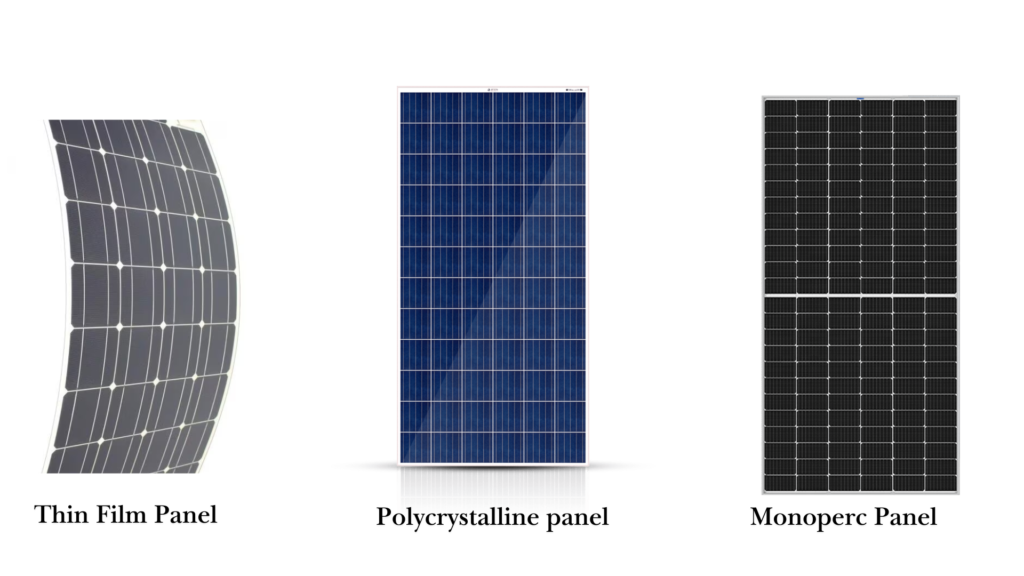
Thin Film, Polycrystalline, Monocrystalline & TOPCon — Which is Best for You?
The solar industry has seen rapid technological progress in recent years. For homeowners and businesses planning to invest in solar rooftop systems, understanding the different solar panel technologies is crucial before making a decision.
In this blog, we’ll break down each major type — Thin Film, Polycrystalline, Monocrystalline (including PERC), and the latest TOPCon modules — along with their benefits, limitations, and best-fit use cases.
☀️ 1. Thin Film Solar Panels
🔍 What Are They?
Thin film solar panels are made by depositing one or more thin layers of photovoltaic (PV) material onto a substrate such as glass, plastic, or metal.
Common materials used include:
- Amorphous Silicon (a-Si)
- Cadmium Telluride (CdTe)
- Copper Indium Gallium Selenide (CIGS)
These panels are lightweight, flexible, and affordable, but they have lower efficiency compared to crystalline panels.
✅ Advantages:
- Lightweight & Flexible: Ideal for surfaces that cannot bear heavy loads (e.g., sheds, curved roofs, or portable systems).
- Performs better in low light: Works efficiently even under diffused sunlight.
- Uniform appearance: Sleek and aesthetic, often used in architectural applications.
❌ Disadvantages:
- Lower efficiency (10–13%) compared to crystalline modules.
- Requires more area for the same power output.
- Shorter lifespan and more degradation over time.
🏠 Best for:
Large commercial roofs or unique architectural projects where weight and aesthetics are more important than efficiency.
Example:
Thin film panels are used on factory roofs or bus shelters where flexibility and light weight are crucial.
Learn more:
🔷 2. Polycrystalline Solar Panels
🔍 What Are They?
Polycrystalline panels (also known as multicrystalline) are made by melting multiple silicon crystals together.
They have a distinct blue shade and a grainy texture due to multiple crystal boundaries.
✅ Advantages:
- Affordable: Lower production cost compared to monocrystalline panels.
- Good efficiency (15–17%) for budget-conscious buyers.
- Proven technology: Decades of reliability in the Indian market.
❌ Disadvantages:
- Slightly less efficient than monocrystalline modules.
- Requires more roof space for the same power generation.
- Less heat tolerance: Efficiency drops faster in high temperatures.
🏠 Best for:
Residential rooftops or schools/institutions where budget and reliability matter more than high efficiency.
Example:
A 3 kW polycrystalline rooftop system can generate around 12–13 units/day in Bangalore under good sunlight.
Learn more:
⚫ 3. Monocrystalline & PERC Solar Panels
🔍 What Are They?
Monocrystalline panels are made from a single silicon crystal, giving them a black, uniform appearance and high electrical conductivity.
PERC (Passivated Emitter and Rear Contact) is an advanced version of monocrystalline technology that adds a reflective layer on the back of the cell to absorb more sunlight and increase efficiency.
✅ Advantages:
- High efficiency (19–22%) — converts more sunlight into electricity.
- Performs well in low light and high temperatures.
- Compact design: Generates more power from the same roof area.
- Long lifespan: Usually 25+ years with minimal degradation.
❌ Disadvantages:
- Higher cost compared to poly panels.
- More sensitive to shading: Even a small shadow can affect output.
🏠 Best for:
Residential rooftops, offices, and commercial buildings where space is limited but performance is key.
Example:
A 5 kW monocrystalline PERC system can produce around 20–22 units/day, while occupying less roof space than polycrystalline panels.
Learn more:
⚙️ 4. TOPCon Solar Modules (Tunnel Oxide Passivated Contact)
🔍 What Is TOPCon?
TOPCon is one of the most advanced solar cell technologies available today.
It’s an upgrade to the PERC cell structure — adding an ultra-thin oxide layer and a doped polysilicon layer at the rear side of the cell, allowing better electron passivation and higher conversion efficiency.
⚡ Key Features:
- Efficiency up to 24% — higher than PERC.
- Improved temperature coefficient: Performs well even in India’s hot climates.
- Enhanced durability and lower degradation over 25 years.
- Better low-light performance.
✅ Advantages:
- Higher energy yield over the system’s lifetime.
- Great for industrial and high-demand projects.
- Compatible with existing manufacturing lines (easier transition from PERC).
❌ Disadvantages:
- Slightly more expensive as the technology is newer.
- Limited availability in some regions, though expanding rapidly.
🏭 Best for:
High-efficiency rooftop and ground-mounted projects where maximum performance and long-term returns are the priority.
Example:
A 10 kW TOPCon system can generate around 45–48 units/day, about 5–7% more energy than the same-rated PERC system.
Learn more:
⚖️ Comparison Table: Which Panel Is Right for You?
| Type | Efficiency | Cost | Space Needed | Durability | Best For |
|---|---|---|---|---|---|
| Thin Film | 10–13% | Low | High | Medium | Large commercial roofs |
| Polycrystalline | 15–17% | Medium | Medium–High | High | Budget residential systems |
| Monocrystalline / PERC | 19–22% | Medium–High | Low | Very High | Homes & offices with limited space |
| TOPCon | 22–24% | High | Very Low | Very High | Premium and industrial systems |
🌍 Final Thoughts
When choosing a solar panel, there’s no single “best” type — the ideal choice depends on your energy needs, roof space, and budget.
For Indian homeowners, monocrystalline PERC or TOPCon panels offer the best balance of performance, reliability, and long-term savings.
However, thin film and polycrystalline options can still be excellent for large, cost-sensitive projects.
🤝 Need Expert Guidance?
Thank you for taking the time to read this article.
If you’re planning to install a rooftop solar system for your home or business, I’ll personally assist you with system design, sizing, and subsidy support.
📞 Contact: +91 86608 21746
📧 Email: brindavansolutions@gmail.com
🏢 Company: Brindavan Solutions, Bangalore
I’ll help you choose the right solar technology and ensure your investment delivers the best returns.
👉 Interested in solar? Get your free proposal and site survey with just one click!
Chat with us on WhatsApp
